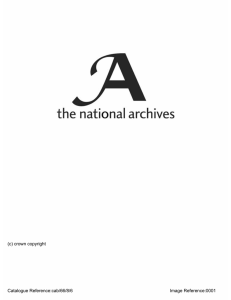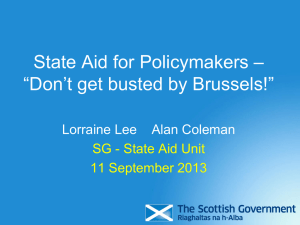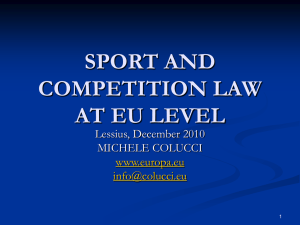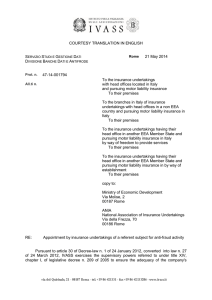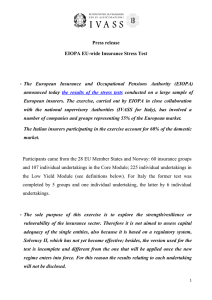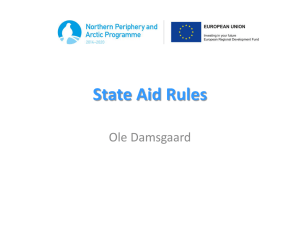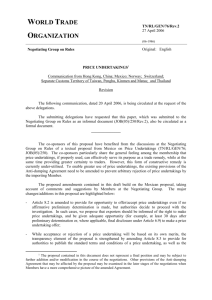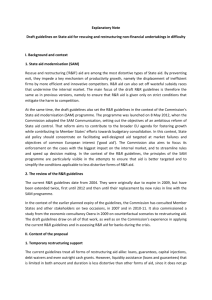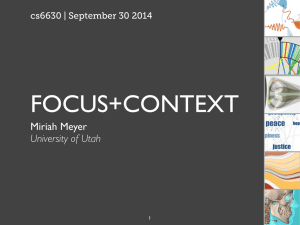State Aid and Public intervention towards projects in Scotland`s
advertisement
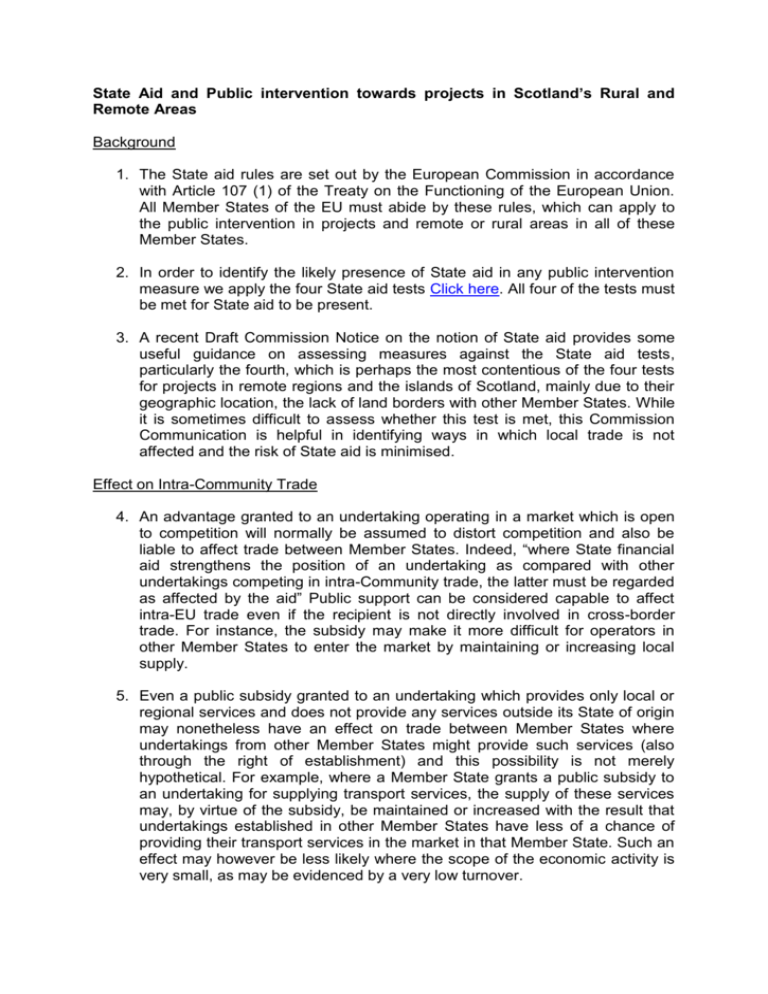
State Aid and Public intervention towards projects in Scotland’s Rural and Remote Areas Background 1. The State aid rules are set out by the European Commission in accordance with Article 107 (1) of the Treaty on the Functioning of the European Union. All Member States of the EU must abide by these rules, which can apply to the public intervention in projects and remote or rural areas in all of these Member States. 2. In order to identify the likely presence of State aid in any public intervention measure we apply the four State aid tests Click here. All four of the tests must be met for State aid to be present. 3. A recent Draft Commission Notice on the notion of State aid provides some useful guidance on assessing measures against the State aid tests, particularly the fourth, which is perhaps the most contentious of the four tests for projects in remote regions and the islands of Scotland, mainly due to their geographic location, the lack of land borders with other Member States. While it is sometimes difficult to assess whether this test is met, this Commission Communication is helpful in identifying ways in which local trade is not affected and the risk of State aid is minimised. Effect on Intra-Community Trade 4. An advantage granted to an undertaking operating in a market which is open to competition will normally be assumed to distort competition and also be liable to affect trade between Member States. Indeed, “where State financial aid strengthens the position of an undertaking as compared with other undertakings competing in intra-Community trade, the latter must be regarded as affected by the aid” Public support can be considered capable to affect intra-EU trade even if the recipient is not directly involved in cross-border trade. For instance, the subsidy may make it more difficult for operators in other Member States to enter the market by maintaining or increasing local supply. 5. Even a public subsidy granted to an undertaking which provides only local or regional services and does not provide any services outside its State of origin may nonetheless have an effect on trade between Member States where undertakings from other Member States might provide such services (also through the right of establishment) and this possibility is not merely hypothetical. For example, where a Member State grants a public subsidy to an undertaking for supplying transport services, the supply of these services may, by virtue of the subsidy, be maintained or increased with the result that undertakings established in other Member States have less of a chance of providing their transport services in the market in that Member State. Such an effect may however be less likely where the scope of the economic activity is very small, as may be evidenced by a very low turnover. 6. In principle, trade can also be affected even if the recipient exports all or most of its production outside the Union, but in such situations the effect is less immediate and cannot be assumed from the mere fact that the market is open to competition. In establishing a distortion of competition or an effect on trade, it is not necessary to define the market or to investigate in detail the impact of the measure on the competitive position of the beneficiary and its competitors. All that must be shown is that the aid is such as to be liable to affect trade between Member States and to distort competition. Exceptions and Precedents 7. Despite the apparent difficulties in demonstrating intra-community trade is not affected, the Commission has in several cases considered that, due to their specific circumstances, certain activities had a purely local impact and consequently did not affect trade between Member States. Common features of such decisions are that: (a) the aid does not lead to demand or investments being attracted to the region concerned and does not create obstacles to the establishment of undertakings from other Member States; (b) the goods or services produced by the beneficiary are purely local or have a geographically limited attraction zone; (c) there is at most a marginal effect on the markets and on consumers in neighbouring Member States; Some examples are: 1 swimming pools and other leisure facilities intended predominantly for a local catchment area1; small harbours and marinas for predominantly recreational crafts2 museums or other cultural infrastructure unlikely to attract visitors from other Member States3; hospitals and other health care facilities aimed at a local population4; news media and/or cultural products which, for linguistic and geographical reasons, have a locally restricted audience5; a conference centre, where the location and the potential effect of the aid on prices is unlikely to divert users from other centres in other Member States6; Commission Decision on State aid N 258/2000 Leisure Pool Dorsten, OJ C 172, 16.6.2001, p. 16. State aid and the effect on trade criterion – Commission paper - The Netherlands: measures in favour of non-profit harbours for recreational crafts 3 Commission decisions in State aid cases N 630/2003 Local Museums Sardinia, OJ C 275, 8.11.2005, p. 3 and SA.34466 Cyprus – Center for Visual Arts and Research, OJ C 1, 4.1.2013, p. 10. 4 Commission decisions in State aid cases N 543/2001 Ireland – Capital allowances for hospitals, OJ C 154, 28.6.2002, p. 4 or SA.34576 Portugal – Jean Piaget North-east Continuing Care Unit, OJ C 73, 13.03.2013, p. 1. 5 Commission’s decisions in State aid cases N 257/2007 Subsidies for theatre productions in the Basque country, OJ C 173, 26.07.2007, p. 1; N 458/2004 Editorial Andaluza Holding; SA.33243 Jornal de Madeira, OJ C 131, 28.05.2005, p. 12. 6 Commission's decision in State aid case N 486/2002 Sweden – Congress hall in Visby, OJ C 75, 27.03.2003, p. 2. 50 2 8. Using these precedents, there are further general examples where there may not be a distortion of EU trade, including: • Business units, shops and social enterprise activities that serve predominantly the local community; • Improved access to land, and; • Village halls. 9. In its assessment of a measure in Poland, the European Commission found that public funding of commercially used infrastructure did not constitute State aid because they were of a scale (two rooms for training and conference purposes with a capacity of 20 people and accommodation facilities also with a capacity of 20) that wouldn’t distort tourist flows from other Member States. 10. In another example, when the Commission investigated several non-profit organisations (mostly sailing clubs) that had received public funding to improve marinas, it concluded that some local distortion of competition was probable but that this was not on a scale sufficient to distort intra-EU trade. The key criterion that assisted this conclusion was that foreign tourists used only 0.25% - 14% of moorings in these marinas. 11. In some cases it may be possible to argue that undertakings operating in a rural location will be unlikely to affect intra community trade but this may not always be the case depending on factors such as size and access to markets. 12. The scale of activity that may be judged to affect intra community trade will differ between markets and should therefore be assessed on a case by case basis. Summary 13. In conclusion, projects that are small in nature, operate in unprofitable markets, remote in location, and/or not traded or marketed beyond the UK border are not likely to involve State aid. Even grants of less than €200,000 should not be given under the de minimis regulation if they do not constitute State aid because that will limit their subsequent ability to receive it for other purposes. 14. If projects do involve economic activity on a scale that is sufficient to distort intra-EU trade, the State Aid Unit can advise on how to fit the aid within the limits of the appropriate regulations. 15. Sole competence on the presence, or otherwise, of State aid rests with the European Court - it is important to note, therefore, that any ‘no aid’ argument will by definition have some risk attached without full notification of the measure to the European Commission.
